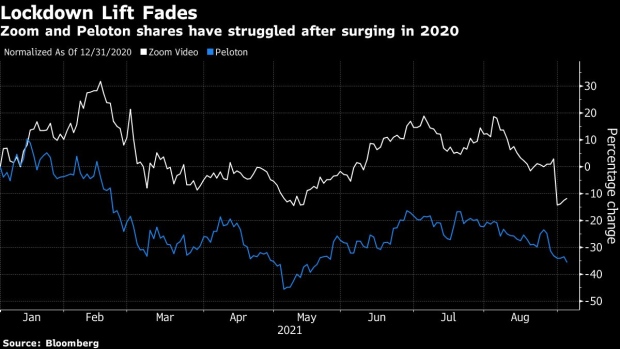Sep 4, 2021
Back to Uncertainty Replaces Back to School for the Stock Market
, Bloomberg News

(Bloomberg) -- Back to school. Back to work. Back to what? That’s the question Wall Street stock traders are trying to answer.
Across the U.S., hopes for a post-Labor Day return to normalcy are being dashed by surging Covid cases from the fast-spreading delta variant. And that uncertainty is showing up in various corners of the market, where some stocks are bucking conventional expectations.
Last year, there were clear winners from America’s Covid lockdowns, like Zoom Video Communications Inc. and Peloton Interactive Inc., which provided people with tools to maintain their lifestyles without leaving the house. They were among the hottest stocks of 2020, both rising around 400% last year.
But 2021 is a new year, and now the shares are struggling as the companies no longer offer investors ways to position for ongoing pandemic restrictions. Peloton is down 41% from its January high and faces product recalls and shrinking interest in its pricey at-home fitness products. While Zoom, the video-conferencing platform that became ubiquitous for work meetings and virtual social gatherings, has seen its stock price virtually cut in half since last October, and it recently gave a sales forecast that further stoked fears of slowing growth.
Even with the slump, the group of lockdown beneficiary stocks is still too expensive to be an attractive way to play the rocky reopening, according to Tim Murray, capital markets strategist in T. Rowe Price’s multi-asset division. The market is taking a longer-term view, expecting a lot of the trends that started in the pandemic, like broader digital adoption and increased remote work, to continue into the future, he said.
“The shifts that are happening now aren’t really consistent with the whole Covid winners, Covid losers of a year ago,” Charles Schwab Chief Investment Strategist Liz Ann Sonders said. “This is not an environment where you want to make major sector calls because sector rotation has been so rampant and it’ll drive investors crazy.”
Picker’s Market
Meanwhile, other lockdown beneficiaries keep climbing. The FAAMG group of tech giants, which largely fueled the S&P 500 Index’s 16% gain last year, have all extended their rallies. E-commerce companies Shopify Inc., eBay Inc. and Etsy Inc. have notched double-digit gains in 2021. Netflix Inc. hit a fresh all-time high on Thursday, and then again on Friday. And DoorDash Inc., the largest food delivery company in the U.S., has climbed 41% since June 9.
The divergence in the performance of these stocks and companies like Peloton and Zoom shows that investors need to be thinking like stock pickers rather than focusing on entire groups.
Take the retail industry. The consumer discretionary sector was the second-best performing group in the S&P 500 last year, after technology. The companies are now in the midst of a strong back-to-school shopping season, with Deloitte LLP projecting a 16% year-over-year jump in consumer spending. This along with better-than-expected quarterly results have kept the shares of many retailers afloat.
Dick’s Sporting Goods Inc., for example, has surged almost 160% this year and is up about 40% since the start of August after reporting blowout second-quarter earnings and boosting its full-year guidance. Jerome Griffith, chief executive officer of major school uniform-maker Lands’ End Inc., said earlier this week that the delta variant doesn’t appear to be hurting uniform sales.
But the lingering pandemic is an issue for retail too, just not in the way you’d expect. Their challenges include protracted supply chain issues and rising costs, both of which are tied to Covid’s continued resilience. And they threaten to overshadow a strong back-to-school shopping season due to the difficulties of getting merchandise to stores and the soaring costs on each step in the supply chain. These headwinds have caused executives to temper their margin outlooks for the second half of the year, which includes the all-important holiday shopping period.
Finding Good Deals
Bloomberg Intelligence analyst Poonam Goyal said inflation is high and doesn’t seem to be going away, so retailers are figuring out how to deal with higher costs. The bigger concern, she said, is whether they can get their shelves stocked in time for the holiday season as they continue to face factory closures and shipping delays.
Kohl’s Corp. took steps to bring in merchandise early to deal with the supply-chain issues, but the shares are still down about 13% since hitting a high in May. And Urban Outfitters Inc.’s stock has tumbled 22% since hitting a peak earlier this year after the company expressed concerns about simply getting inventory. And just last week, Abercrombie & Fitch Co. shares sank 10% after its sales came in shy of expectations due to shipping delays and factory shutdowns in Vietnam.
To Goyal, the issue is that while manufacturing capabilities can be relocated, “are you leaving sales on the table because you didn’t have the inventory?”
Credit Suisse analyst Michael Binetti expected the Covid-related supply chain challenges to have eased by now. In June and July of 2020, off-price retailers didn’t have inventory on their shelves. But merchandise started to fill back up around last year’s back-to-school season, and Binetti thought at that time that retailers were in “pretty good shape,” he said in an interview. However, the recovery has actually been “more uneven” and “volatile” than he expected.
“We aren’t out of this yet,” he said.
Looking ahead from here, Goyal considers those off-price retailers -- like TJX Cos., Ross Stores Inc. and Burlington Stores Inc. -- to be well positioned to shrug off any supply chain disruptions since they don’t have to offer a certain product mix or carry specific items.
“For them, it’s just wherever they can find a good deal,” she said. Investors have to be thinking the same way when it comes to picking stocks that will thrive in these uncertain times.
©2021 Bloomberg L.P.





